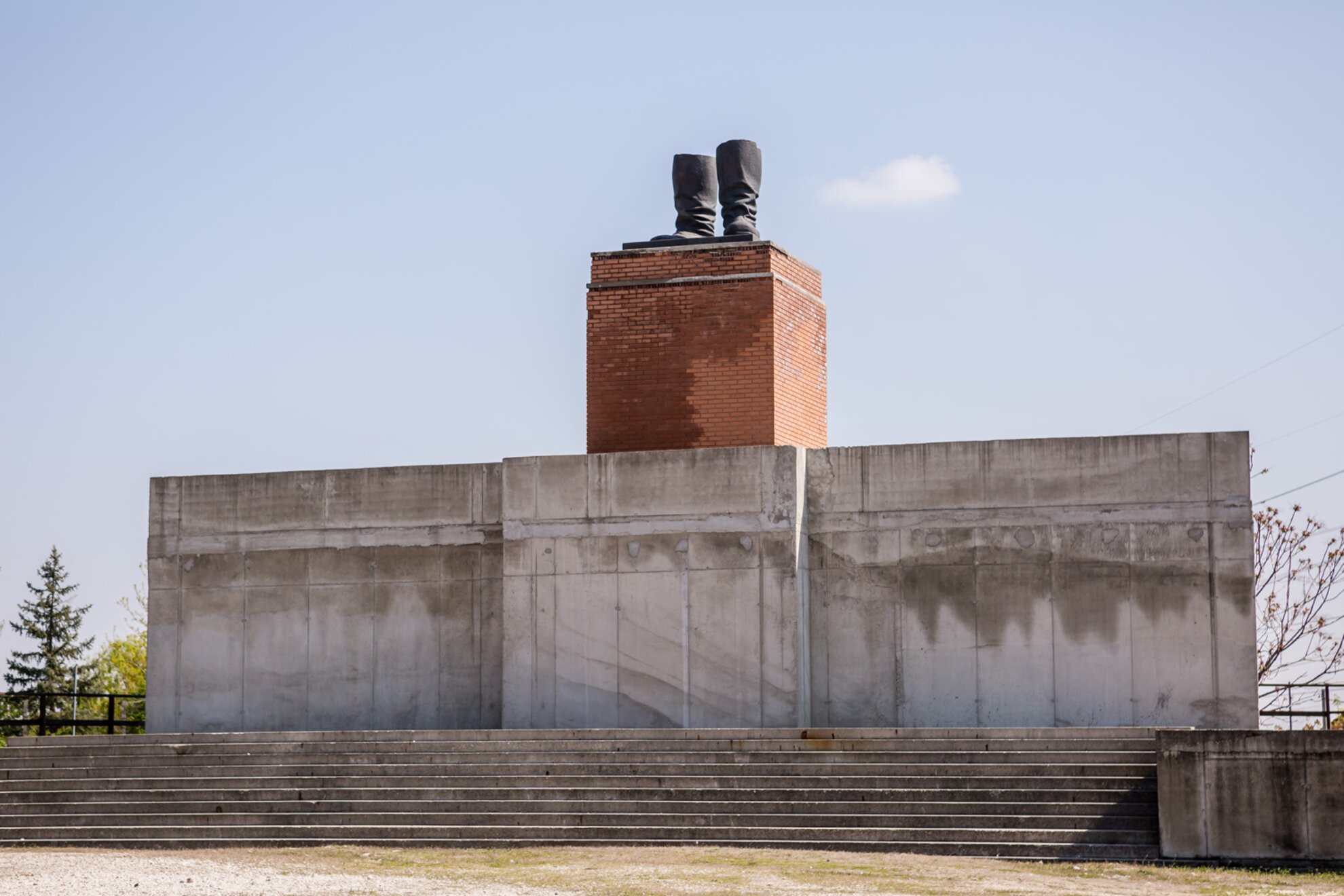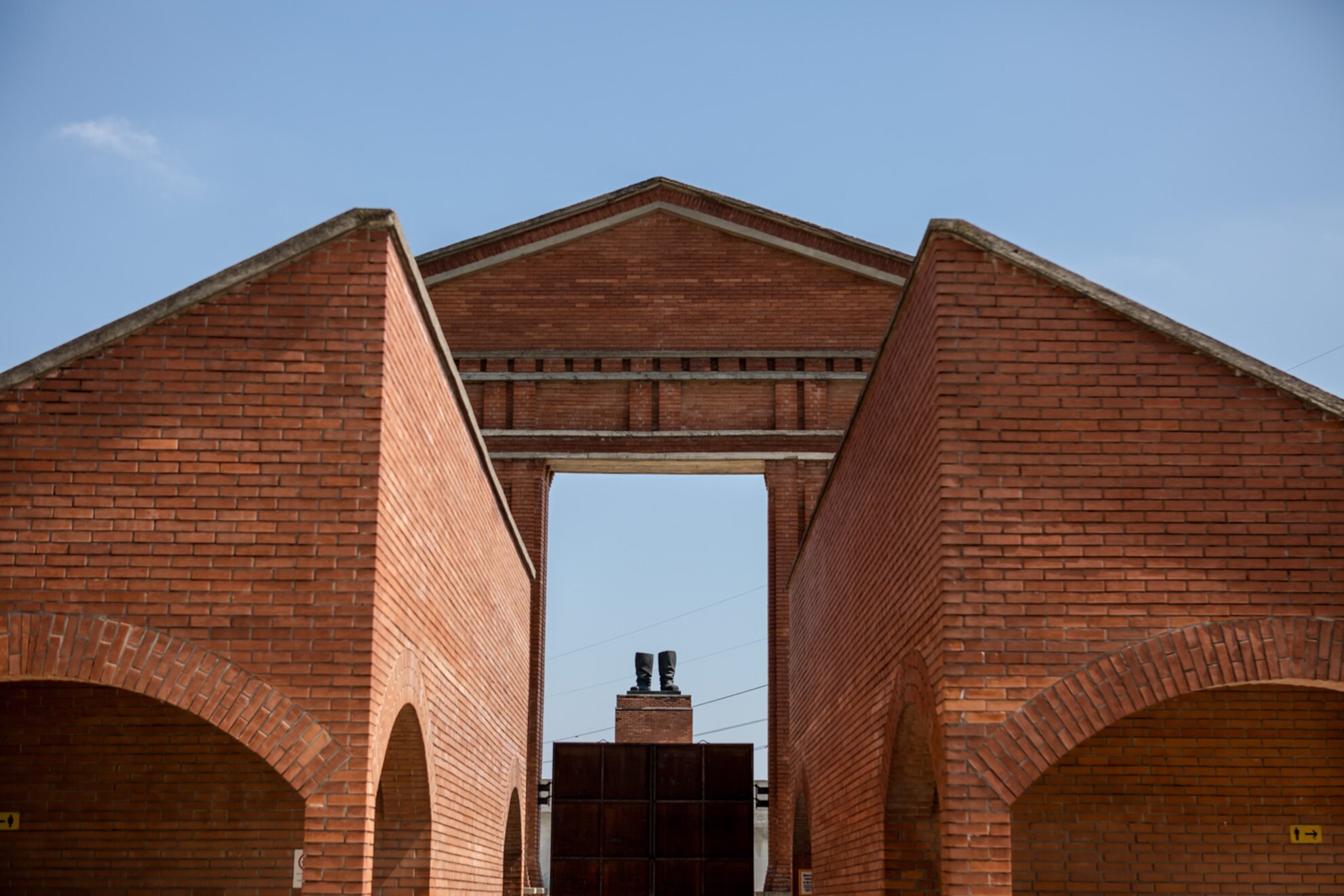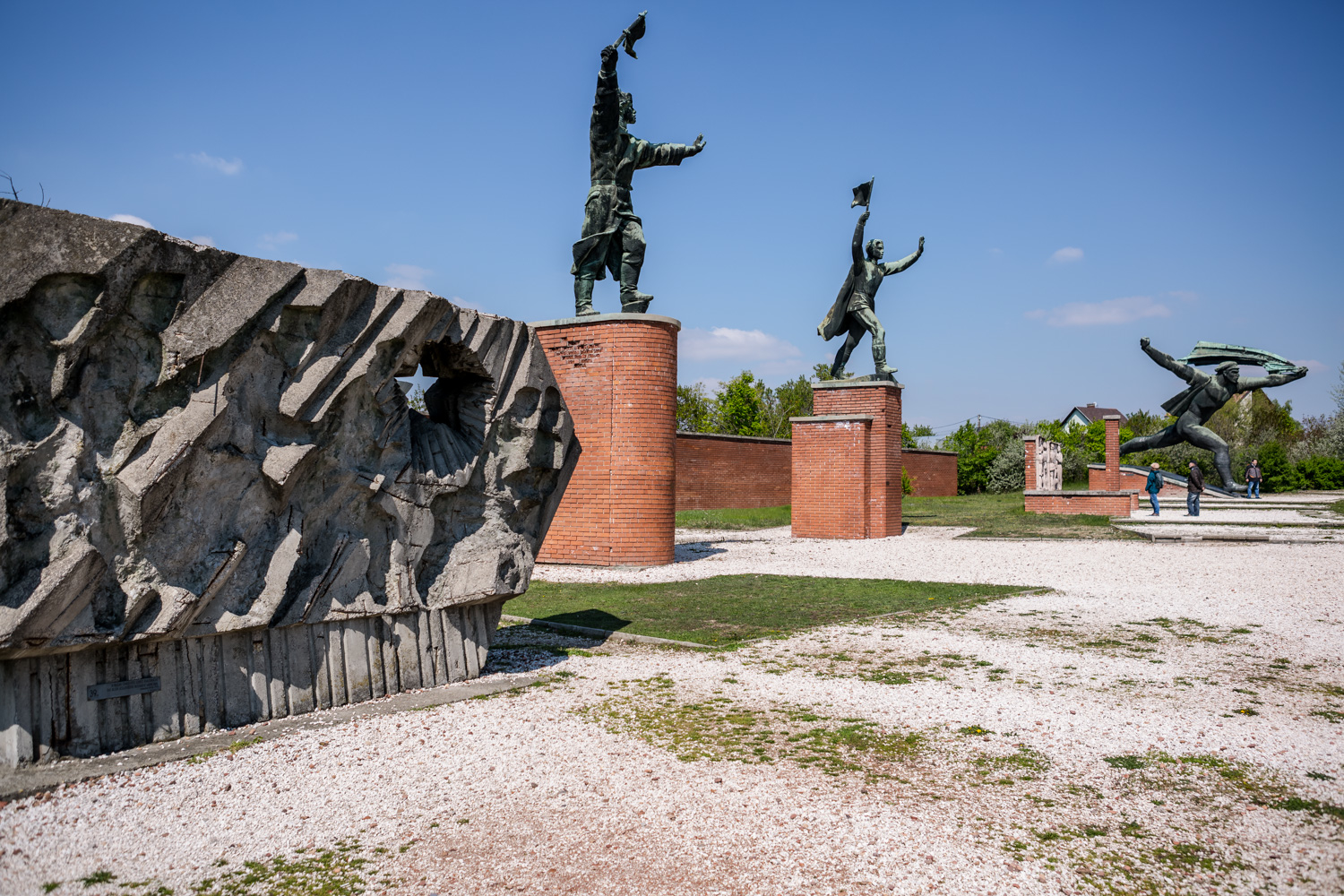After World War II, many colossal statues glorifying communist heroes and ideals were erected across Budapest by the occupying Soviet forces. However, after the regime change in 1989-1990, city authorities cleared away most of these sculptures, and many were donated to District XXII’s Memento Park, an open-air museum built to provide visitors with glimpses into Hungary’s turbulent 20th-century history. Nowadays, anyone can see these dramatic statues by embarking on a public-transport journey, first by boarding the driverless trains of the M4 metro line to disembark at the subway's Kelenföld vasútállomás terminus. From here we ascend from the underground station to switch to bus line 101E, which takes Memento Park visitors on a nine-minute journey to drop them off (the map) just a short walk away from the museum’s entrance. From this point, it’s hard to miss the way to the outdoor exhibition space – gigantic statues of communist dictators and fictional role models from the era of repression tower above a massive concrete wall, indicating that those who enter here are about to leave modern-day Budapest behind to travel on a road that demonstrates how oppressive regimes gained control over entire populations in history by creating a cult around tyrant personalities.

However, Memento Park doesn’t serve as a statue cemetery, nor is it about publicizing autocrats – instead the museum’s main quest is to present the fall of a broken ideology by showcasing thematically displayed communist-era artworks, while the guided group tours that take visitors around the 24-year-old educational site are often spiced up with just the right amount of sarcasm. As our edifying trip kicks off outside the museum’s wall, our head turns towards a gigantic grandstand with Stalin’s bronze-made boots perched atop a high pedestal. This is a full-scale replica of Felvonulási Square’s historic dais, on which an eight-meter-tall statue of Stalin stood before it was sawed off below the knees and pulled down during the Hungarian Revolution of 1956, when the Magyars rose up against Soviet oppression.

Opposite to this emblematic work of art, an antique-style entryway is adorned with Cubist monuments that display the iconic duo of communist ideologists Marx and Engels on one side, and Lenin’s bronze statue on the other side. Between the historic depictions, a massive iron gate suggests access to a mystical world, but the oversized port doesn’t open – instead visitors can enter the enclosed Statue Park area of the Memento Park complex through an unpretentious gate placed adjacent to the main entryway, a symbolic portal standing as a reference to a paradigm of day-to-day life during communism, stating “next to every big door, there is a small gate”.The deceptively stirring sounds of the socialist movement blast in the air as we start our walk inside the Statue Park, where a surreal souvenir store welcomes our group with military songs played from the shop’s “Best of Communism” CD. The tiny stall is filled with all sorts of bittersweet keepsakes, including redLenin-shaped candles, fridge magnets in the form of the iconic communist red-star symbol, colorful propaganda posters, and much more; this quirky facility also serves as the museum’s ticket counter. A shopping list of must-buy items is already forming in our heads, but the tour continues and we have to stay with the group, making us almost feel like disappointed kids who didn’t get their festival souvenirs.

However, we manage to wipe our imaginary tears away when we reach the next destination of the tour, where a communist-era Trabant car is parked to welcome anyone inside to feel historic Hungary’s retro vibe. In addition to this rolling sensation, those who have questions for Lenin or one of Hungary’s communist leaders can get them on speed dial from a vintage telephone booth placed near the vintage vehicle – instead of inserting coins, the telephone can be operated after solving a riddle, and in return for our efforts we can listen to propaganda speeches delivered by the bombastic leaders.

After crossing a narrow alley that leads us from this playful site to where the museum’s thought-provoking sculptures are kept, a semi-forgotten world unfolds before our eyes with colossal carved constructions scattered around an open space. However, these trophies of Soviet-era sculpting are not just placed haphazardly inside Memento Park, but they are systematically organized along a central road that leads visitors around the museum, while a five-point red star is made of flower beds to mark the epicenter of the park. Three routes open from this main path to form a shape of an infinity sign, suggesting that any path we embark upon will always lead us back to the central “only true and right road”, referring to a key element of communist ideology. The museum’s well-planned layout resembles the strategic placing of the statues on major Budapest squares and roads during the oppressive era.

While traversing the vast parkland, we feel that an intimidating atmosphere surrounds the place as robust Russian military men represent forceful power, including the statue of the Liberating Soviet Soldier that strikes a confident pose while standing tall and holding a communist-symbol flag in his hand, with a machine gun at his side. Back in the day, this bronze figure was visible from much of downtown Budapest, when it adorned Gellért Hill as a counterpart to the city’s now-70-year-old Liberation Monument – one of very few oversized communist-era statues that remains on display in its original city-center site.Among the fearful figures, many of the propaganda statues depict foreign armed forces standing alongside Magyar citizens, including the Hungarian-Soviet Friendship Memorial that portrays a scene of an open-hearted Budapest resident greeting an ill-disposed Soviet soldier. In addition to gazing at these petrifying artworks from an era of occupation, we learn how the ideal woman was perceived during communist times, while other pieces demonstrate distinct members of the communist worker’s class represented as empowering role models. Meanwhile, our guide explains that in certain cases, the portrayed person’s real characteristics had nothing to do with their bronze-casted depictions: a sheer representation of this trend is the statue of Endre Ságvári – an ordinary clerk and workers’ movement member who was presented as a role model for the youth – where the sculptor was forced to ignore Ságvári’s unattractive features and instead make his bust look like a Greek athlete.

The intriguing collection of Memento Park is complete with additional statues of Lenin, including a bronze-casted memorial made by the Csepel Iron and Metal Works (Budapest’s historic industrial complex), and it marks the last monument that was set up inside the Statue Park.

Those who navigate the central path of Memento Park with detours taken along the circular routes finally reach the end of the road, where Captain Steinmetz (a Hungarian leader of the Red Army) and Captain Ostapenko of Ukraine peak high in the sky – the duo of commanders once towered above major junctions at the city’s boundaries, and now stand side by side to bid farewell to Memento Park visitors. However, instead of an exit, we run into a massive wall, indicating that the road of communism doesn’t lead anywhere, and we can only turn back to walk down the same path again.Before we leave the terrifyingly evocative open-air exhibition ground, our guide jokingly points at one of Memento Park’s most iconic statues, the Monument of the Hungarian Socialist Republic, which once dominated one of City Park’s tree-flanked sides – during Hungary’s communist regime, this bizarre giant was nicknamed the “ Cloakroom Attendant”, who runs after someone saying, “Sir, you forgot your scarf!”, and the multilingual guides at Memento Park often conclude the tours with this lighthearted remark.

Upon leaving Memento Park’s enclosed estate, we head back to the starting point of our tour at the Stalin grandstand, but instead of continuing to examine the memorial from the outside, we go around the pedestal to descend into an out-of-sight viewing space under this gigantic work of art. Under the bronze boots, a concealed stock of artworks is stored that are not part of the Statue Park’s ordinary displays. Recently, this warehouse-like collection has been completed with a number of freshly added attractions, including a rarely seen portrayal of Lenin as a five-year-old child, giving an innocent look and smile to viewers. This one-of-a-kind statue stood at one of Lake Balaton’s Pioneer Movement sites (a communist-era summer camp for children), and after the sculpture’s inauguration to the public during the Night of Museums on June 24th it will enhance Memento Park’s underground artwork collection, along with other newly revealed relics.

Before we catch a ride back to downtown, we pass by a duo of ramshackle wooden barracks. One of these dilapidated establishments houses a dimly lit exhibition with photos demonstrating the Hungarian Revolution of 1956 and Budapest scenes during the change of regime in 1989-1990. Besides these stirring images, a separate hall of the building is home to a small screening hall where Hungarian film director Gábor Zsigmond Papp’s Life of an Agent documentary plays with original Hungarian audio and English subtitles – the movie is made of 15-minute sets extracted from educational films used by communist-era secret-service forces. The film theater was created to resemble the concept of a news cinema, where anyone can enter anytime and leave whenever they feel like it.

By the end of our visit we are ready to return to our modern-day lifestyle, and we suddenly start appreciating the freedom we often take for granted, like our option to choose a suitable conveyance that takes us back to the city center. There are plenty of alternatives for traveling between central Budapest and Memento Park, including regular services by the BKK public-transport company. From the Kelenföld vasútállomás station of the M4 metro line, the 101B and 101E buses take visitors to the Statue Park on weekdays, and the journey takes approximately ten minutes. On weekends, bus line 150 drops visitors at Memento Park from the Kelenföld vasútállomás M4 station, and those who take this leisurely ride can download an English-language bonus guide from the museum’s website that explains the sights seen along the 25-minute journey to the park.Meanwhile, Memento Park also operates direct transfers with buses departing every day at 11am from Budapest’s Deák Square, and leaving Memento Park at 1pm for downtown – this service is available from May 1st through January 10th, with a full-price ticket costing 4,900 forints per person, including the museum pass. Those who purchase this all-inclusive ticket online get a 40% discount from the original price.

Passengers who take this direct bus service from downtown reach the museum in time to join the English-language guided tour of Memento Park, which starts every day at 11:45am. These walks are often tailor-made to the audience, so school groups are usually provided with easy-to-understand guidance, while by request the park’s elderly visitors who lived under the communist regime can get more in-depth information during the trip. In addition to these on-site tours, multilingual guidebooks are sold at the museum’s souvenir shop, or they are available to be downloaded from Memento Park’s official website for 1,500 forints.




